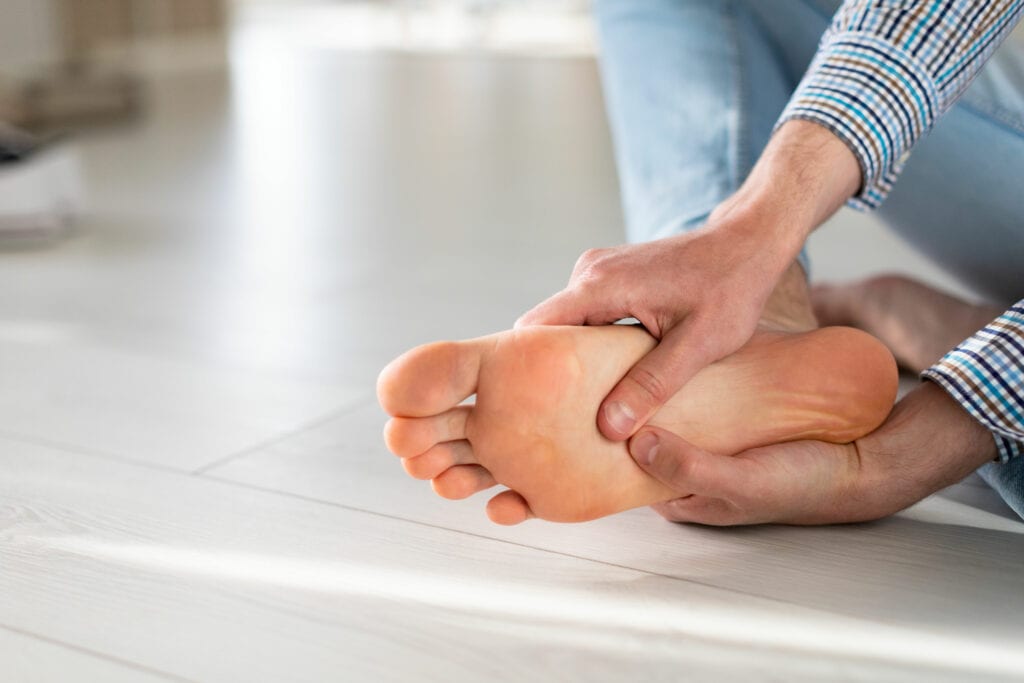What Plantar Fasciitis Feels Like And How It’s Treated

From simply supporting our weight on a daily basis to the brutal demands of sports and high-intensity exercise, our feet have a sometimes thankless job. But when our feet start aching and hurting, we stand up and take notice. One of the most common types of foot pain and injury is plantar fasciitis — about 1 in 10 people will suffer from it at some point in their lives.
Let’s walk through the symptoms of plantar fasciitis and give you some insight into how it’s treated.
WHAT IS PLANTAR FASCIITIS?
In simple terms, plantar fasciitis is an inflammation or swelling of the plantar fascia, which is a thick band of tissues connecting your heel bone to your toes.
The plantar fascia supports the arch of your foot and absorbs the force of shock from your every footfall. The weight and force of your body is first applied to your feet through the heel (at the connective tissue of the plantar fascia). Pain from plantar fasciitis occurs when the weight of your body causes the thick bands of your plantar fascia to become stretched or inflamed.
WHAT CAUSES PLANTAR FASCIITIS?
There are a lot of factors that can contribute to the inflammation of the plantar fascia, but it boils down to unusual stress on the bands. The weight and force of your body is first applied to your feet through the heel (at the connective tissue of the plantar fascia). Pain occurs when your weight is improperly spread across the plantar fascia bands from your heel to your toes.
Here are a few potential causes of plantar fasciitis:
- If your foot rolls inward or outward, your plantar fascia can become stretched and abnormally pull the bands, causing pain.
- If you have poor arch support in your shoes, have poor cushioning in your shoes, or walk barefoot too much, you could potentially injure your plantar fascia.
- If you increase your activity in a sport with repetitive food pounding (think tennis and basketball) too quickly, don’t train properly for exercise, or receive a sports injury, you can damage your plantar fascia.
Ultimately, it’s not always possible to pinpoint one specific thing that might cause plantar fasciitis, but it’s worth knowing what can put you at additional risk for an injury.
WHAT DOES PLANTAR FASCIITIS FEEL LIKE?
Pain from plantar fasciitis is generally felt first on the bottom of the foot in the heel. It will feel as though there’s a deep pain in the front of the heel (sometimes dull and sometimes sharp), though the entire bottom of the foot may be affected.
Oftentimes you’ll feel this pain first thing in the morning — or after a long rest — and it will dissipate as the day goes on. The pain can return if you spend a large part of your day on your feet.
Your physician will often diagnose plantar fasciitis based on a physical examination and an explanation of your symptoms. Imaging will likely not be required in most cases.
HOW IS PLANTAR FASCIITIS TREATED?
Naturally, the treatment depends on the individual and the level or type of inflammation.
Because plantar fasciitis is an inflammation, a physician may suggest over-the-counter medication such as ibuprofen or naproxen to relieve the pain.
Your physician may also suggest some therapies as well, including orthotics for arch support, night splints to help stretch your calf and arch while you sleep, and physical therapy to stretch your plantar fascia and strengthen your leg muscles.
If your pain persists for several months and the more conservative treatments aren’t helping, your physician may suggest injections, shock wave therapy, ultrasonic tissue repair, or even surgery.
CONSULT THE DOCTORS AT ABOITE PODIATRY
If you’re experiencing a sharp, stabbing pain in the heel of your foot, don’t wait to get it looked into.
Our doctors at Aboite Podiatry are trained to identify and treat conditions such as plantar fasciitis and other foot-related issues. Make an appointment to meet with one of our skilled podiatrists today by calling 260-436-3579.
